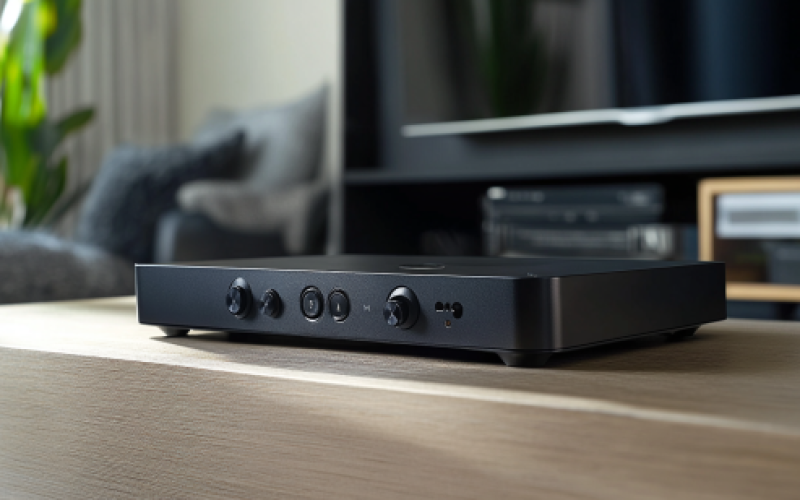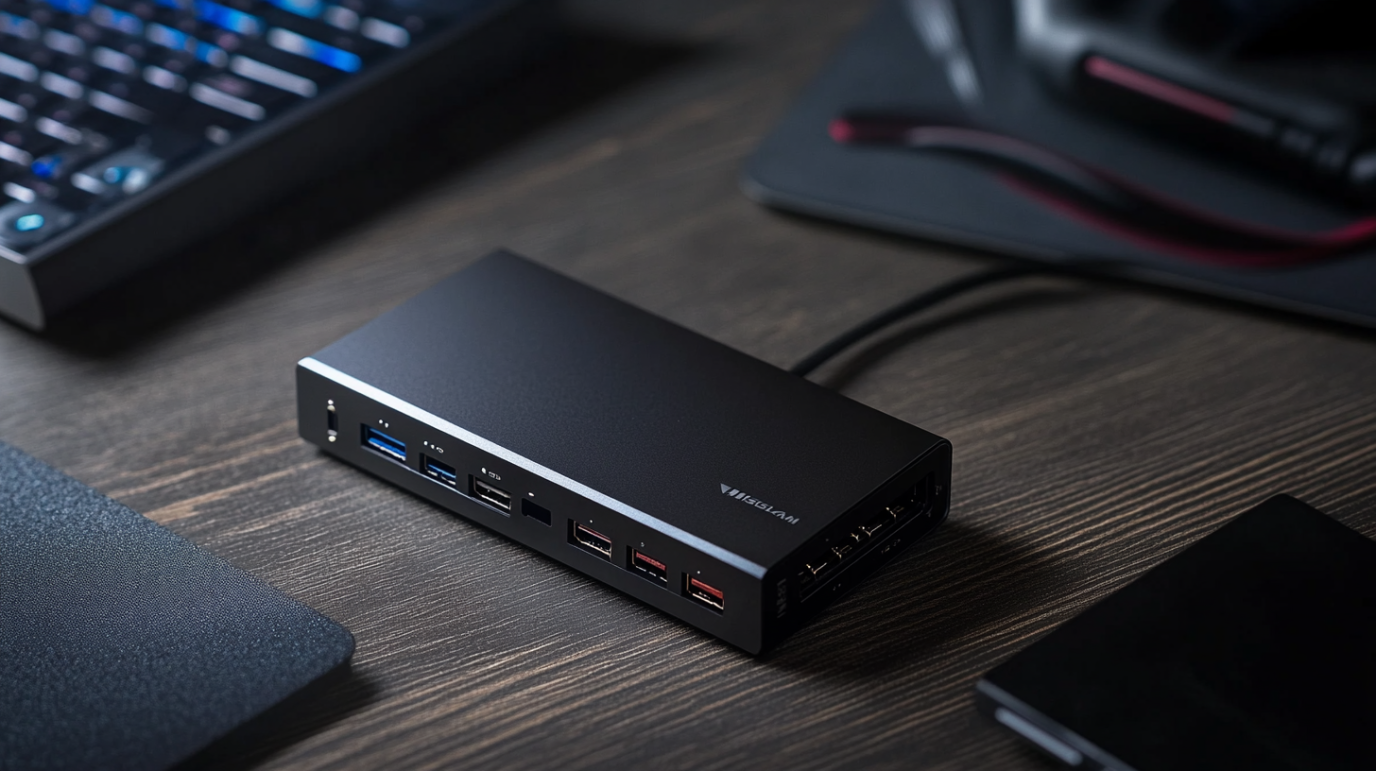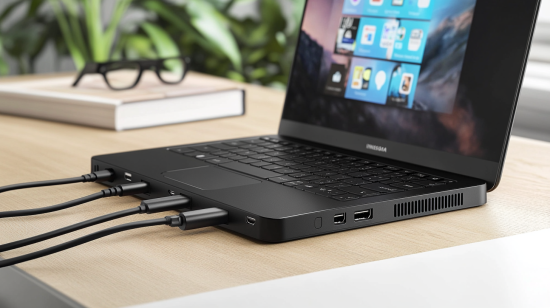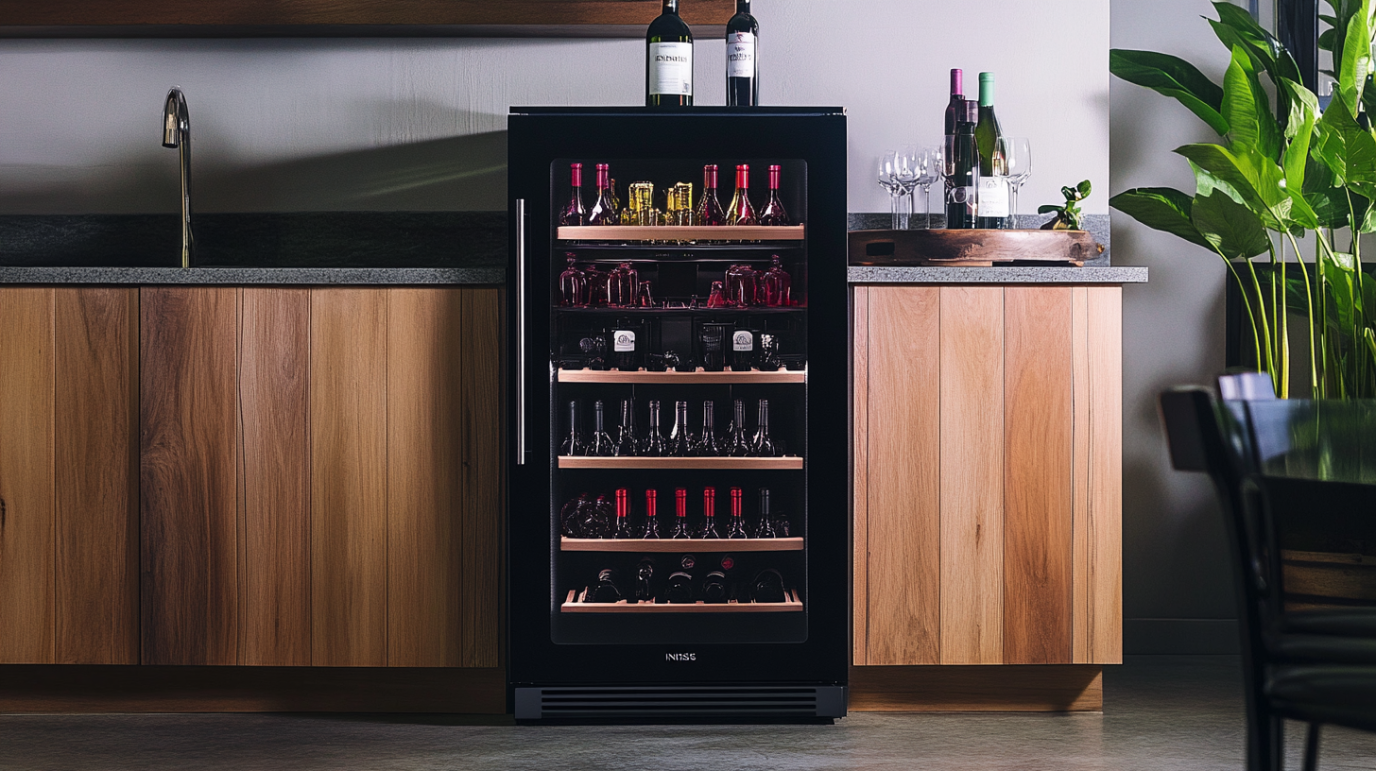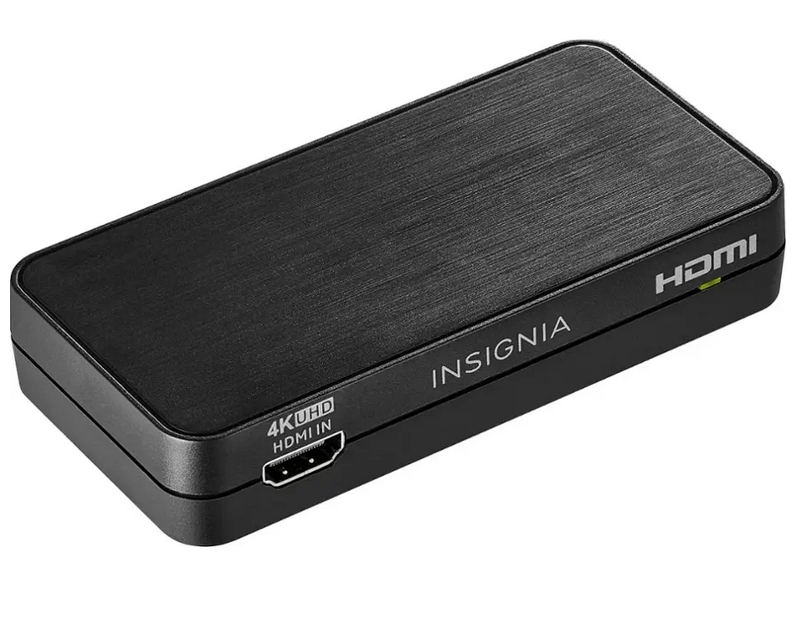
Insignia™ – HDMI Audio Extractor with 4K @ 60Hz / HDR Support – Black
- Insignia HDMI audio extractor Lets you easily extract audio signals for playback from your speakers, headphones and more.
- 3.5mm stereo and optical outputs Send audio to your headphones, soundbar, or other audio device.
- HDMI input/output Passes video without degradation and supports 4K @ 60Hz / HDR signals.
- Audio mode selector switch Allows for 2-channel analog or up to 5.1-channel digital output for maximum compatibility.
- RCA-to-3.5mm adapter included Provides additional audio connection options. Note: HDMI and audio cables not included.
- Wide Range Compatibility Compatible with PS5, X-Box Series X, DVD, PC, and most streaming boxes.
$49.99
Unlocking Audio Freedom in Your Living Room: A Hands-On Journey
When I first encountered audio sync issues with my fancy new 4K TV, I felt that familiar tech frustration creeping in. The picture was crystal clear, but the audio? Let’s just say it wasn’t winning any awards. After countless hours of troubleshooting and research, I discovered what would become the unsung hero of my entertainment system: the Insignia HDMI Audio Extractor. This modest device revolutionized my setup in ways I never expected, and I’m here to share everything I’ve learned about this game-changing gadget.
My Audio Extraction Awakening
Before diving into the technical details, let me paint you a picture. Imagine watching an intense action sequence where the timing between explosions on screen and the sound coming from your speakers is noticeably off. Or trying to enjoy dialogue that sounds muffled through your TV’s built-in speakers when you have a perfectly good sound system collecting dust. These were my daily struggles until the Insignia HDMI Audio Extractor solved my audio routing problems once and for all.
I’m writing this comprehensive guide to help fellow audio enthusiasts and home theater buffs understand what makes this particular audio extractor worth considering. Whether you’re looking to connect older audio equipment to modern video sources, solve frustrating audio sync issues, or simply improve your overall listening experience, this guide will walk you through everything you need to know.
What Exactly Is the Insignia HDMI Audio Extractor?
The Insignia HDMI Audio Extractor is, at its core, a problem-solving device. It’s a compact box that sits between your video source (like a streaming device, gaming console, or Blu-ray player) and your display. Its primary function is elegantly simple yet incredibly powerful: it extracts the audio signal from an HDMI connection and provides separate audio outputs, allowing you to route sound to different audio devices while maintaining the video connection to your display.
Think of it as a traffic director for your audio and video signals. The HDMI input receives both signals together, and then the extractor separates them, sending video onwards through an HDMI output while simultaneously directing audio to either analog (3.5mm headphone jack or RCA) or digital (optical/TOSLINK) outputs.
For someone like me who wanted to use high-quality speakers with a modern streaming device, this solved a fundamental connection challenge. No more compromising on sound quality just because my audio system lacked HDMI inputs!
The Price Point: Is It Worth Your Investment?
One of the first questions that crossed my mind when researching audio extractors was about cost. Would this be yet another expensive addition to my already pricey entertainment setup? I was pleasantly surprised to discover that the Insignia HDMI Audio Extractor is remarkably affordable, especially considering the functionality it provides.
At the time of writing, the Insignia HDMI Audio Extractor typically retails between $30-$40, positioning it in the mid-range of audio extractors. This price point makes it accessible to most consumers without sacrificing essential features.
When evaluating this cost, I considered what I was getting for my money: a solution to audio routing problems, compatibility with my existing equipment, and improved audio quality. For me, the math was simple – the enhancement to my entertainment experience far outweighed the modest investment.
What’s particularly appealing is that you’re getting a brand-backed product from Insignia (Best Buy’s in-house brand) at a price point comparable to generic alternatives. This gave me additional confidence in the purchase, knowing I was getting reliable quality and the possibility of customer support if needed.
Where to Purchase Your Insignia HDMI Audio Extractor
Given that Insignia is Best Buy’s house brand, the most straightforward place to purchase the Insignia HDMI Audio Extractor is from Best Buy itself. Their physical stores typically carry it in the audio accessories section, and it’s readily available on their website.
I personally purchased mine during a weekend trip to my local Best Buy, where a helpful associate guided me through the options. However, if you prefer online shopping, Best Buy’s website offers the convenience of home delivery or store pickup, often with detailed customer reviews to help inform your decision.
Beyond Best Buy, I’ve noticed the Insignia extractor occasionally available through other major online retailers. Price comparison is worthwhile, as I’ve sometimes seen slight variations or seasonal promotions that might save you a few dollars.
While shopping, I recommend checking the return policy. Best Buy typically offers a standard return window (usually 15 days, extended for reward members), which provides peace of mind if the extractor doesn’t integrate with your setup as expected.
Key Features That Set the Insignia HDMI Audio Extractor Apart
After using the Insignia HDMI Audio Extractor for several months, I’ve come to appreciate several standout features that make it particularly valuable in my setup:
Multiple Audio Output Options
The versatility of audio outputs is perhaps what I appreciate most about this device. The Insignia extractor provides three distinct audio output options:
- Optical (TOSLINK) Output: Perfect for connecting to sound bars, AV receivers, or any audio device with digital optical input. This maintains digital audio quality while supporting 5.1 surround sound formats.
- 3.5mm Stereo Output: Ideal for connecting headphones or powered speakers with a standard auxiliary input. This has been incredibly useful when I want private listening without disturbing others.
- RCA Stereo Outputs: The red and white analog connections that work wonderfully with older stereo systems or powered speakers. I use these to connect to a vintage amplifier that lacks digital inputs.
This trio of options means the extractor can integrate with virtually any audio system, whether cutting-edge or classic.
Resolution Support
When I first considered adding an audio extractor to my setup, my primary concern was whether it would compromise my video quality. I was delighted to discover that the Insignia model supports 4K resolution (3840×2160) at 30Hz, which means I can enjoy Ultra HD content while benefiting from separated audio.
For most of my viewing, which includes streaming services and gaming at 1080p, the extractor handles everything flawlessly without any noticeable degradation in picture quality.
Audio Format Compatibility
The Insignia extractor supports a range of audio formats, including standard stereo and multichannel PCM. While it doesn’t support the highest-end formats like Dolby Atmos or DTS:X (which we’ll discuss more later), it comfortably handles the most common audio formats used in everyday content consumption.
Compact and Unobtrusive Design
I appreciate that the extractor features a minimalist black design that blends seamlessly with other components in my entertainment center. Measuring roughly 2.4 x 2.4 x 0.6 inches, it’s compact enough to tuck behind other equipment without requiring significant space.
The simple LED indicator provides visual confirmation that the device is powered and functioning, which I’ve found helpful for troubleshooting.
Plug-and-Play Functionality
Perhaps one of the most user-friendly aspects of the Insignia extractor is its straightforward setup. There are no complicated menus, software installations, or configuration procedures. You simply connect your cables according to the clearly labeled ports, power it up, and it works. This no-nonsense approach was refreshing compared to some of the more complex audio equipment I’ve configured in the past.
How the Insignia HDMI Audio Extractor Actually Works
Understanding the operational principles of the extractor helped me appreciate its capabilities and limitations. At its most basic level, the device works by demultiplexing (separating) the audio and video signals that travel together through an HDMI cable.
When an HDMI signal is transmitted from a source device like a streaming stick or game console, it carries both video and audio data in a single digital stream. The extractor intercepts this stream, separates the audio portion, and converts it to the appropriate output format while allowing the video portion to pass through unaltered to your display.
For analog outputs (3.5mm and RCA), the extractor includes a digital-to-analog converter (DAC) that transforms the digital audio signal into analog waveforms that can drive speakers directly. For the optical output, it reformats the digital audio data to meet the optical transmission standards.
The entire process happens instantaneously, with no perceptible delay between video and extracted audio – a crucial factor for maintaining proper audio-video synchronization.
Power for this operation comes from the included external power adapter, which connects to a standard wall outlet. This external power source ensures that the extraction and conversion processes don’t rely on power from the HDMI connection itself, which could potentially be inadequate for reliable operation.
4K Compatibility: Can It Handle Your Ultra HD Content?
As a 4K content enthusiast, this question was particularly important to me. The Insignia HDMI Audio Extractor supports 4K resolution (3840×2160) at 30Hz, which is sufficient for most streaming content, standard broadcast, and many gaming applications.
However, it’s worth noting that it doesn’t support 4K at 60Hz or higher refresh rates, which might be a consideration for serious gamers or those with the latest gaming consoles pushing high frame rates at 4K resolution. For my personal use case, which involves primarily streaming movies and casual gaming, the 30Hz limitation hasn’t been problematic.
The extractor also supports High-Definition Digital Content Protection (HDCP) 1.4, which is compatible with most content sources. Some newer content protected by HDCP 2.2 might pose compatibility challenges, although I’ve rarely encountered this issue in practical use.
If you’re primarily using 1080p (Full HD) content sources, the extractor performs flawlessly with no resolution constraints, handling 1080p at 60Hz without any issues.
Dolby Atmos and DTS-HD Support: Understanding the Limitations
For audiophiles and home theater enthusiasts, audio format support is a critical consideration. Here, it’s important to set realistic expectations about what the Insignia HDMI Audio Extractor can and cannot do.
The Insignia extractor does not support advanced audio formats like Dolby Atmos, DTS:X, or DTS-HD Master Audio in their full glory. This limitation stems from the bandwidth constraints of the optical output, which can’t carry the full data rate required by these advanced formats.
The extractor supports standard Dolby Digital and DTS formats through its optical output, providing 5.1 channel surround sound for compatible receivers. For stereo content, it performs excellently through all output options.
In my own setup, which uses a 5.1 channel system, the audio quality has been more than satisfactory for movie watching and gaming. However, if you’ve invested in a high-end Atmos setup with height channels or an 11.2 channel system, you’ll want to consider a more specialized solution that maintains HDMI throughout the chain to preserve these advanced audio formats.
Gaming Console Compatibility: PS5, Xbox Series X, and More
As both a cinephile and a gamer, I needed an extractor that would work seamlessly with my gaming consoles. I’ve tested the Insignia HDMI Audio Extractor with several gaming systems, and here’s what I’ve found:
PlayStation 5 Compatibility
The extractor works with the PS5, allowing you to split audio to external systems while maintaining video to your display. However, because of the 4K/30Hz limitation mentioned earlier, serious PS5 gamers who want to experience 4K gaming at 60fps or 120fps will need to either play at lower resolutions or consider a higher-spec extractor.
For most PS5 games at 1080p, the experience is excellent with no noticeable input lag or audio sync issues introduced by the extractor.
Xbox Series X Compatibility
Similar to the PS5, the Xbox Series X works with the Insignia extractor, but with the same 4K/30Hz limitation. If you’re playing competitive games where high frame rates are crucial, you might want to use the console’s direct HDMI connection to your display instead.
For casual gaming and especially for using the Xbox as a media center, the extractor performs admirably, allowing you to route game audio through better speakers than your TV provides.
Nintendo Switch and Other Consoles
The Nintendo Switch, which typically outputs at 1080p or lower resolutions, works perfectly with the Insignia extractor. Since the Switch doesn’t push beyond 60Hz even in docked mode, you won’t encounter any resolution or refresh rate limitations.
Older consoles like the PS4, Xbox One, and various retro systems connected through HDMI adapters all function without issues through the extractor.
Maximum Resolution Support: What to Expect
To summarize the resolution capabilities of the Insignia HDMI Audio Extractor:
- 4K (3840×2160) at 30Hz
- 1080p (1920×1080) at 60Hz
- 720p (1280×720) at 60Hz
- Standard definition resolutions (480p/576p)
The device also supports various color spaces, including RGB and YCbCr, ensuring compatibility with most source devices and displays.
For most everyday viewing situations, these specifications are more than adequate. Only those with specific high-frame-rate 4K gaming needs or requirements for 4K/60Hz HDR passthrough might find these limitations restrictive.
Optical Audio Output: A Digital Audio Enthusiast’s Perspective
The optical (TOSLINK) output on the Insignia HDMI Audio Extractor is perhaps its most valuable feature for serious audio enthusiasts. This digital connection maintains signal integrity over longer distances and is immune to electrical interference that can affect analog connections.
The optical output supports PCM stereo and compressed Dolby Digital/DTS formats, making it ideal for connecting to AV receivers, soundbars, and digital audio processors. I’ve found the optical connection particularly valuable for maintaining clean, noise-free audio transmission to my receiver.
One limitation to be aware of is that the optical output is restricted to 2-channel PCM or compressed 5.1 formats due to bandwidth constraints of the TOSLINK standard itself (this is not unique to the Insignia extractor). This means multichannel PCM audio (uncompressed surround) will be downmixed to stereo when using the optical output.
For most users connecting to soundbars or AV receivers that can decode Dolby Digital, this won’t be an issue. In my everyday use with streaming services and gaming, the optical output has performed flawlessly, delivering clear, synchronized audio to my surround sound system.
Setting Up the Insignia HDMI Audio Extractor: A Step-by-Step Guide
One of the most appealing aspects of the Insignia extractor is its straightforward setup process. Here’s how I integrated it into my system, which should be similar for most home entertainment setups:
Basic Setup Steps:
- Position the extractor in an accessible location near your source devices and display. I placed mine on a shelf below my TV, making sure it had adequate ventilation.
- Connect your source device (streaming box, game console, Blu-ray player, etc.) to the “HDMI IN” port on the extractor using a high-quality HDMI cable.
- Connect your display (TV or monitor) to the “HDMI OUT” port on the extractor using another HDMI cable.
- Choose your audio output:
- For digital surround sound, connect an optical cable from the extractor’s “OPTICAL” output to your sound system’s optical input.
- For analog stereo, connect either the 3.5mm output to powered speakers/headphones or use the RCA outputs with the appropriate cables.
- Connect the power adapter to the extractor and plug it into a wall outlet. The power LED should illuminate, indicating the device is operational.
- Turn on your source device and display. You should see video on your screen immediately.
- Select the appropriate input on your audio device to hear sound through your chosen connection.
For most setups, no additional configuration is required – the extractor should work immediately. If your display or audio system requires specific settings adjustments, consult their respective manuals.
Troubleshooting Tips from Personal Experience:
If you encounter issues during setup, here are some solutions I’ve discovered:
- No video output: Ensure all HDMI cables are securely connected and that your TV is set to the correct input. Try different HDMI cables if the problem persists.
- No audio output: Check that your audio device is powered on and set to the correct input. For optical connections, remove any protective caps from the cable ends.
- Audio sync issues: If you notice a slight delay between video and audio, many modern TVs and sound systems have audio delay adjustments that can compensate for this.
- HDMI handshake problems: Occasionally, HDMI devices can have difficulty establishing communication. If this occurs, try powering off all devices, then power them back on in this order: extractor, display, source device.
ARC Compatibility: Understanding the Limitations
Audio Return Channel (ARC) is a feature that allows TVs to send audio back down an HDMI cable to a receiver or soundbar, reducing cable clutter. It’s important to note that the Insignia HDMI Audio Extractor does not support ARC functionality in the traditional sense.
The extractor is designed to work in one direction – taking audio from a source device and separating it before it reaches your display. It cannot extract audio that originates from smart TV apps or other sources connected directly to your TV.
If ARC functionality is essential to your setup, you would need to:
- Connect the extractor between your source device and sound system, then connect the sound system to your TV, or
- Consider a more specialized device designed specifically for ARC extraction.
In my setup, I addressed this limitation by connecting all my source devices through the extractor rather than relying on my TV’s built-in apps, ensuring all content benefits from better audio quality through my external sound system.
Stereo vs. Surround Sound Support: What You Need to Know
The Insignia HDMI Audio Extractor supports both stereo and surround sound, but with some important distinctions across its different outputs:
Stereo Support:
All three output options (3.5mm, RCA, and optical) support standard stereo audio perfectly. For music listening, podcasts, and basic TV watching, any of these connections will provide excellent stereo performance.
I’ve found the analog outputs (3.5mm and RCA) particularly useful for connecting to older stereo systems, powered bookshelf speakers, and headphones. The sound quality through these connections is clean and free from digital artifacts.
Surround Sound Support:
For surround sound, you’ll want to use the optical output connected to a compatible receiver or sound bar. The Insignia extractor supports standard Dolby Digital and DTS formats (compressed 5.1 channel audio) through its optical output.
As mentioned earlier, it does not support uncompressed multichannel PCM, Dolby Atmos, DTS:X, or other advanced formats. For most users with 5.1 channel systems, this won’t be a significant limitation, as the majority of content is available in compatible formats.
In my entertainment system, I’ve connected the optical output to my 5.1 channel receiver, and it has handled the surround sound for movies and games impressively well, with distinct channel separation and immersive sound field.
Comparing the Insignia HDMI Audio Extractor to Competitors
After researching and testing various extractors, I’ve found that the Insignia model occupies a sweet spot in terms of features, performance, and price. Here’s how it compares to other options on the market:
Budget Alternatives:
There are cheaper generic extractors available, often priced $10-15 lower than the Insignia model. While these may provide basic functionality, I’ve found they often lack build quality and reliability. Several friends who opted for the absolute cheapest options reported issues with durability, signal stability, and even power supply failures.
The modest premium for the Insignia brand brings better quality control and the backing of a major retailer, which provides valuable peace of mind.
Higher-End Alternatives:
On the premium end, brands like J-Tech Digital and ViewHD offer extractors with additional features like:
- 4K/60Hz passthrough
- HDR support
- HDCP 2.2 compatibility
- Advanced audio format handling
These premium options typically cost $20-50 more than the Insignia model. For specific use cases – particularly high-end gaming at 4K/60Hz or Dolby Atmos passthrough – these premium options make sense.
However, for typical home theater use with streaming services, cable/satellite TV, and casual gaming, the Insignia extractor provides the essential functionality without the premium price tag.
The Value Proposition:
What makes the Insignia extractor compelling is its balance of necessary features, reliable performance, and reasonable cost. It handles the core function of audio extraction exceptionally well while maintaining video quality for most common use cases.
Unless you have specific requirements for high-frame-rate 4K gaming or advanced audio formats, the Insignia model likely represents the best value for your needs.
Is the Insignia HDMI Audio Extractor Truly Plug-and-Play?
Based on my experience, I can confidently say that the Insignia HDMI Audio Extractor lives up to its plug-and-play promise. Unlike many audio components that require extensive configuration, the extractor works immediately once properly connected.
There are no software installations, firmware updates, or complex menu systems to navigate. The device has no buttons to press or settings to adjust – it simply does its job silently and efficiently.
This simplicity is particularly valuable in mixed households where not everyone shares the same technical expertise. Anyone can use the entertainment system without needing to understand the intricacies of audio extraction.
The only “configuration” involved is selecting which audio output you wish to use, which is as simple as connecting a cable to the appropriate port. Even if you switch between different audio devices, it’s just a matter of connecting to a different output – the extractor adapts automatically.
Power Requirements: What You Need to Know
The Insignia HDMI Audio Extractor does require external power to function properly. It comes with a 5V DC power adapter that plugs into a standard wall outlet.
This external power requirement is actually beneficial, as it ensures stable operation regardless of how much power your source device provides through the HDMI connection. Some extractors attempt to draw power from the HDMI connection itself, which can lead to instability or failure with certain source devices.
The power consumption is minimal – comparable to charging a smartphone – so it won’t significantly impact your electricity bill. The adapter is compact and doesn’t require a bulky power brick, making it easy to accommodate in an entertainment center.
I’ve found it helpful to connect the extractor’s power adapter to the same surge protector or power conditioner as my other audio/video equipment. This ensures everything powers on and off together and provides protection against power surges.
User Reviews and Experiences: The Consensus
Before purchasing the Insignia HDMI Audio Extractor, I scoured customer reviews across various platforms to get a sense of real-world experiences. The consensus was largely positive, with most users reporting satisfaction similar to my own experience.
Common praise points included:
- Reliable operation with minimal troubleshooting required
- Good build quality compared to cheaper alternatives
- Effective solution for connecting modern sources to older audio equipment
- Clear, interference-free audio through all output options
The most frequent criticisms centered around:
- The 4K/30Hz limitation (as opposed to 4K/60Hz)
- Lack of support for advanced audio formats like Dolby Atmos
- Occasional HDMI handshake issues with certain devices
These criticisms align with the known limitations of the device rather than defects or design flaws. Most negative reviews appeared to stem from users expecting capabilities beyond what the extractor is designed to provide.
After using the extractor myself for several months, I found the positive reviews to be accurate. The device has performed reliably in my system with no unexpected issues or failures.
Durability and Build Quality: Long-Term Reliability
Having used the Insignia HDMI Audio Extractor for an extended period, I can speak to its durability and build quality. The device features a solid metal housing that effectively dissipates heat and provides protection against physical damage.
The input and output ports are firmly mounted to the chassis, showing no signs of loosening even after numerous cable connections and disconnections. This is an improvement over cheaper extractors I’ve tried, where ports sometimes became wobbly after minimal use.
The included power adapter has also proven reliable, maintaining consistent performance without overheating or developing connection issues.
While the extractor lacks the substantial heft of premium audio components, it doesn’t feel cheaply made. The construction quality strikes a good balance for its price point, providing durability without unnecessary cost.
For those concerned about longevity, I’ve spoken with friends who have used their Insignia extractors for 2+ years without failure. This suggests the device can be expected to provide several years of service under normal operating conditions.
Compatible Devices: What Works with the Insignia HDMI Audio Extractor
Through my own testing and research, I’ve compiled a list of devices known to work well with the Insignia HDMI Audio Extractor:
Video Source Compatibility:
- Streaming devices: Amazon Fire TV Stick, Roku, Apple TV, Chromecast
- Gaming consoles: PlayStation 4/5, Xbox One/Series S/X, Nintendo Switch
- Media players: Blu-ray players, DVD players, HTPC systems
- Cable/satellite boxes: Most major providers’ set-top boxes
- Computers/laptops: Any with HDMI output
Display Compatibility:
- Televisions: Any with HDMI input (LCD, LED, OLED, QLED)
- Monitors: Computer monitors with HDMI input
- Projectors: Home theater projectors with HDMI input
Audio Device Compatibility:
- AV receivers: Any with optical, RCA, or 3.5mm inputs
- Soundbars: Models with optical, RCA, or 3.5mm inputs
- Powered speakers: Computer speakers, bookshelf speakers, etc.
- Headphones: Any standard headphones with 3.5mm connector
- Stereo systems: Older systems with RCA inputs
The versatility of having three different audio output options means the extractor can connect to virtually any audio system, regardless of age or design. This backward and forward compatibility is one of the device’s greatest strengths.
Finding Discounts and Promotions for the Insignia HDMI Audio Extractor
If you’re looking to save on your purchase, I’ve discovered several strategies for finding the best deals on the Insignia HDMI Audio Extractor:
Best Buy Promotions:
As an Insignia product, the extractor is occasionally included in Best Buy promotions, particularly during:
- Holiday sales events (Black Friday, Cyber Monday)
- Back-to-school sales periods
- Open-box discounts (floor models or returned items in good condition)
Best Buy’s price match guarantee can also be valuable if you find the extractor at a lower price from a qualifying competitor.
Best Buy Reward Zone Membership:
If you’re a frequent Best Buy shopper, their loyalty program can provide certificates that effectively discount your purchase. Additionally, members often receive exclusive offers not available to the general public.
Seasonal Timing:
I’ve noticed that audio accessories like extractors often see price reductions around January (post-holiday) and September (as new models are introduced). Timing your purchase to align with these periods can yield savings.
Bundle Deals:
Occasionally, the extractor may be offered at a discount when purchased alongside other home theater components. If you’re building or upgrading a system, inquiring about bundle pricing is worthwhile.
While significant discounts on the extractor are relatively rare due to its already reasonable price point, applying these strategies might save you $5-10 on your purchase.
Conclusion: Is the Insignia HDMI Audio Extractor Right for You?
After extensive use and testing, I can confidently recommend the Insignia HDMI Audio Extractor for most home entertainment setups. Its combination of reliability, versatility, and value makes it an excellent solution for common audio routing challenges.
The extractor is particularly well-suited for:
- Connecting modern HDMI sources to older audio equipment
- Enhancing TV audio by using external speakers without sacrificing video quality
- Creating flexible audio routing options for different listening scenarios
- Solving audio format compatibility issues between devices
The Insignia HDMI Audio Extractor solved my audio routing problems once and for all, providing a clean, reliable connection between my various source devices and sound system. The improvement in audio quality compared to my TV’s built-in speakers has been dramatic, transforming my entertainment experience.
While it does have limitations – notably the 4K/30Hz ceiling and lack of support for advanced audio formats – these constraints only affect specific high-end use cases. For the vast majority of users, the Insignia extractor provides all the functionality needed at a price point that represents excellent value.
If you’re struggling with audio routing challenges or simply want to improve your sound quality without investing in an entirely new entertainment system, the Insignia HDMI Audio Extractor deserves serious consideration. It’s a small investment that can make a significant difference in your daily entertainment experience.

